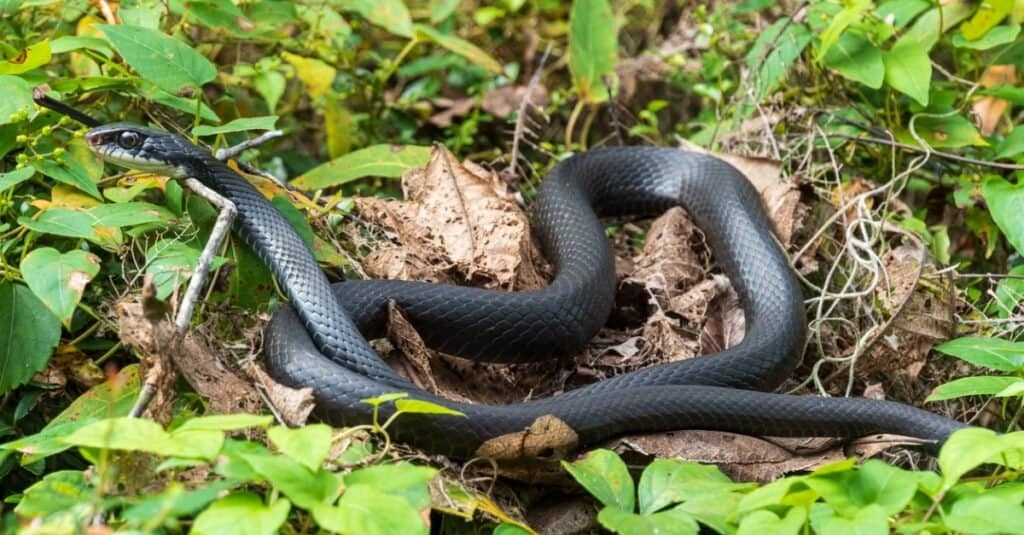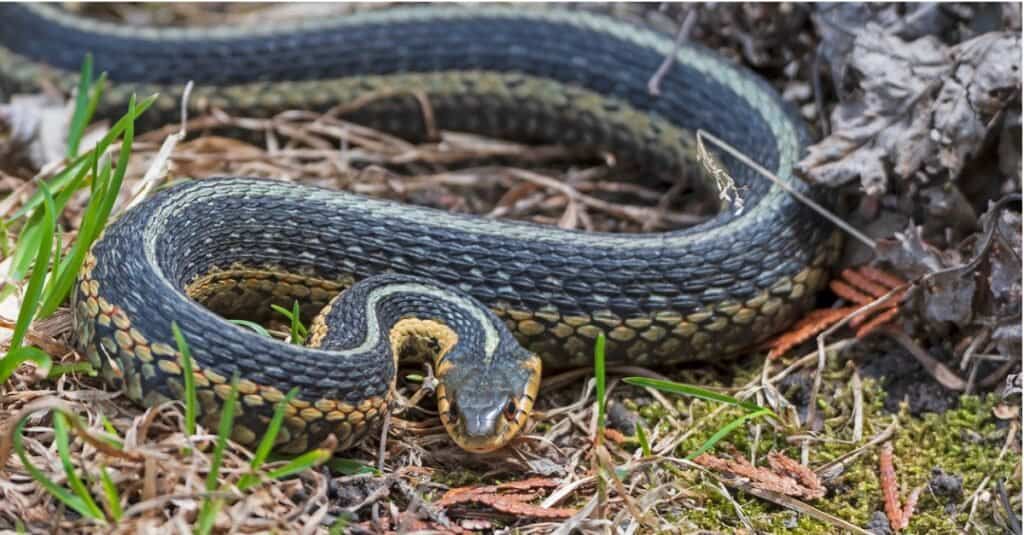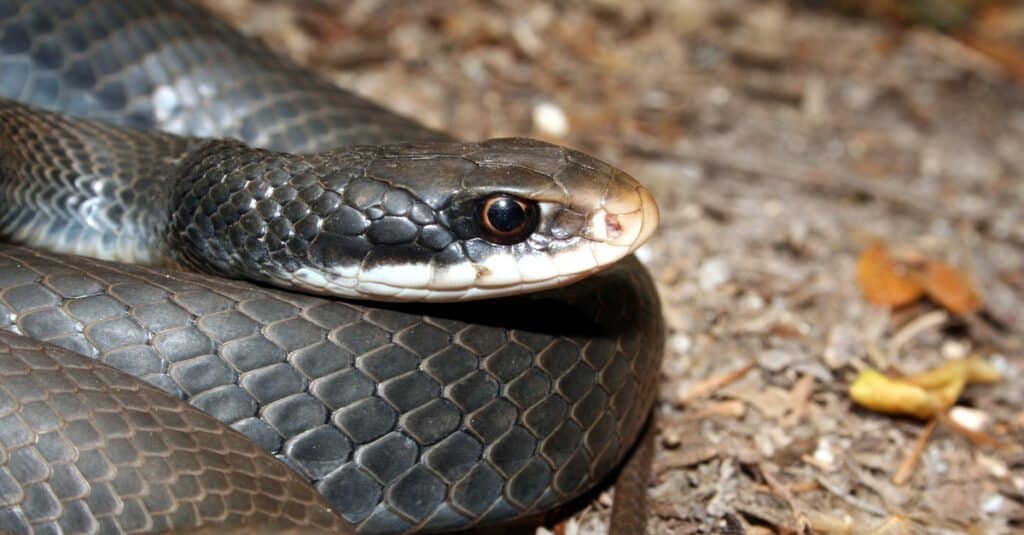North America is home to many snake species, including garter snakes and black racers. But how do you tell the difference when it comes down to the black racer vs garter snake? Both snakes are native to North America, specifically the continental United States. Sometimes, they occupy the same habitats. But, there are a few key differences between black racers and garter snakes.
In this article, we’ll learn about all the ways to tell black racers from garter snakes. We’ll learn more about their size, appearance, habitat, behavior, diet, and lifespan. Let’s look at the black racer vs garter snake and how to tell the two species apart.
Comparing Black Racers And Garter Snakes

| Black Racer | Garter Snake | |
|---|---|---|
| Size | Length: 20-60 inches long Weight: 1-2 pounds | Length: 18-42 inches long Weight: 0.5-1.5 pounds |
| Appearance | Slender body with black or blue-black scales along the back and sides. Lighter belly with white markings on chin and throat. Large red eyes with round pupils | Slender snake with three yellow stripes running from head to tail. Ranges in color from blue-black to brown checkerboard pattern with a lighter belly |
| Location and Habitat | The Eastern United States; shrublands, forests, and flatlands | North America; usually found near water in forests, meadows, wetlands, and suburban areas |
| Behavior | Flees quickly when humans come near; vibrates tail to mimic rattlesnakes; bites repeatedly if handled. | Non-aggressive, commonly found in or around outdoor structures like porches or sheds |
| Lifespan | Up to 10 years | Up to 10 years |
The Key Differences Between Black Racers And Garter Snakes
The key differences between black racers and garter snakes are size, location, habitat, appearance, and behavior. Black racers are generally much bigger than garter snakes, and garter snakes tend to be more brightly colored than black racers. Both species occur in North America. The black racer is a subspecies of North American racer, and is more common in the eastern half of the continental United States. Neither species is aggressive or venomous. Garter snakes give birth to live young, but black racers lay eggs.
Let’s look at the key differences between black racers and garter snakes.
Black Racer vs Garter Snake: Size

Black racers are almost entirely black, except for some white or orange coloring on their throats.
©iStock.com/Sunshower Shots
Garter snakes and black racers are slender snakes with thin, graceful bodies. But, garter snakes rarely exceed 26 inches long (around two feet), though some have been recorded up to 42 inches long. In contrast, black racers grow to be between 20-56 inches long as adults. That means black racers usually grow twice as long as garter snakes.
With those differences in length come differences in weight. Black racers generally weigh between 1-2 pounds, while garter snakes can weigh only half a pound as adults.
Black Racer vs Garter Snake: Location and Habitat

Garter snakes can be found throughout North America, whereas black racers are found only in the eastern United States.
©iStock.com/Wildnerdpix
You’ve probably seen a garter snake if you live in North America. Garter snakes are common throughout the continental United States and parts of Canada. Black racers aren’t nearly as common; they’re not found in the western half of the United States. They’re found throughout the eastern United States, as far north as southern Maine.
When it comes to a black racer vs garter snake, both species live in many of the same places. Black racers are found at the edge of urban and suburban areas, shrublands, forests, and flatlands. Garter snakes have a wide variety of habitats but are often found near water or meadows. They can also be found in suburban areas, forests, wetlands, and shrublands. Further, garter snakes are known for hiding in outbuildings, like sheds or under porches.
Black Racer vs Garter Snake: Appearance

Garter snakes have three solid stripes running from their head to their tail.
©Steve Bower/Shutterstock.com
The most striking difference between black racers and garter snakes is their appearance. As their name suggests, black racers are almost entirely black or blue-black. They have paler bellies and white or orange markings on their chins and throats. Young black racers are light brown, with darker brown diamond-like patterning. As they grow older, they gain their adult black color.
The garter snake’s most distinguishing feature comes from three solid stripes running from the head to the tail. The stripes are usually white to yellow. Beyond the stripes, they exhibit a wide variety of coloring and patterning. They may be solid brown, brown with diamond patterning, or even red-brown to orange.
Both species have narrow heads and large, round eyes. Like all snakes, they have bottom jaws connected only by a thin band of muscles at the front of their mouth. This muscular connection allows them to open their jaws wide enough to swallow prey larger than their heads.
Black Racer vs Garter Snake: Behavior

Black racers are non-aggressive and non-venomous.
©Psychotic Nature/Shutterstock.com
Neither black racers nor garter snakes are venomous. They have no venom glands and no venom-delivering fangs. There are a few differences in the behavior of black racers and garter snakes, though, starting with when they’re active.
Black racers are only active during daylight hours, while garter snakes slither about at all times of the day and night. Further, only black racers vibrate their tails to mimic rattlesnakes, though they have no rattle.
The photo featured at the top of this post is © iStock.com/randimal
Discover the "Monster" Snake 5X Bigger than an Anaconda
Every day A-Z Animals sends out some of the most incredible facts in the world from our free newsletter. Want to discover the 10 most beautiful snakes in the world, a "snake island" where you're never more than 3 feet from danger, or a "monster" snake 5X larger than an anaconda? Then sign up right now and you'll start receiving our daily newsletter absolutely free.
Thank you for reading! Have some feedback for us? Contact the AZ Animals editorial team.






